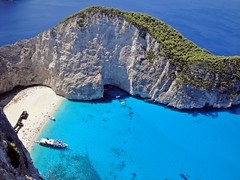Zakynthos Travel Guide

Zakynthos or Zante (Greek: Ζάκυνθος) is a beautiful island in the Ionian Sea, belonging to the Heptanese island complex. It is the eleventh biggest Greek island and it has a population of 38,957 inhabitants as of 2001.
The beauty of Zakynthos is perfectly highlighted in the name given to it by the Venetians, "il fiore di levante", meaning "the flower of the East".
Zakynthos was already inhabited and well-known in the Ancient Greece and it has been mentioned by Homer in the Iliad and later on in the Odyssey with the name Yleessa (Greek: Υλήεσσα), which means forested.
According to Pausanias and Thucydides, the island took the name by which it is still known today around the 1500 BC, from Zakynthos, son of the King of Phrygia, Dardanus.
Zakynthos has particularly rich flora and fauna. The high average yearly precipitation has contributed to the island's plant diversity, which —among others— includes rare species of flowers and other plants. The island is also well-known as being the home for the endangered loggerhead sea turtle Caretta caretta and the critically endangered monk seal Monachus monachus, both of them protected by national and international legislations.
Places to visit
- the beach Xygkia, which is the only one on the island with a sulphur spring, which is believed to have healing properties
- the sea caves on the periphery of the island, as well as Myzithres (majestic giant rocks emerging from the sea)
- the rock forest known as Ascos
- the Strofades islets
- the famous beach, Navagio, with its shipwreck lying on golden sand
- the Bay of Laganas with its magnificent beach, home for the endangered loggerhead sea turtle Caretta caretta, and characterised as National Park since 1999
- the Cape Schoinari in the north of the island and the region Aspros Vrachos, where the magnificent Galazies Spilies (=blue caves) are located
- the beautiful islet of Aghios Sostis in the Bay of Laganas, connected to the main island through a wooden bridge
Monuments and Museums to visit
- the Castle of Zakynthos (built in the late fifteenth century AC), located in the region of Bochali, in which the capital of Zakynthos was fortified during the Venetian rule on the island
- the location Keri, where you can admire the Old Lighthouse and experience an enchanting and unforgettable sunset
- the ruins of the Venetian aqueduct (built in the sixteenth century AC), in the region of Kryoneri
- the Hill of Stranis, where the great poet, Dionysios Solomos, wrote the poem Hymn to Freedom, part of which forms the National Anthem of Greece. The bust of the poet is now found in the centre of the small square on the Hill of Stranis, while his house is located at the top of the hill
- the building of the Messala family, located in the region Lithakia, which is a typical sample of the nineteenth century architectural style in Zakynthos. The building housed the island's Courthouse in the past, and since the end of the 90's it houses the Centre for Environmental Education
- the Public Library, established in the 1628 AC
Events to attend
- the traditions that take place during the Easter period in Zakynthos, such as the breaking of pottery jugs
- the famous carnival of Zakynthos, featuring the Venetian Wedding and the local tradition called Giostra (a type of equestrianism competition)
Food and Drinks to taste
- sgatzeto, a dish served at Holy Saturday's supper and consists of vine tree-smoked salted pork meat
- tradiditional ladotyri cheese
- sartsa, a favourite dish involving veal, olive oil, tomato, garlic, oregano, pieces of ladotyri cheese and spices
- stufado, a dish made with pieces of veal, bay leaves, rosemary, fresh tomatoes, olive oil and spices
- melitzanes skordostoubi (fried aubergines covered with a tomato and garlic sauce and baked in the oven)
- boutridia, i.e. oven-baked vegetables, such as runner beans, aubergines, potatoes, courgettes, okra, onion, garlic, olive oil and spices
- gemisto kouneli (i.e.rabbit stuffed with potatoes, ladotyri cheese and braised in white wine)
- sofigadoura (lamb or goat meat cooked with onion, garlic, tomatoes, potatoes, olive oil, spices and a little white wine)
- frygania sweet, made with dried bread soaked in syrup, covered with custard and optionally topped with whipped cream
- the local sweet delicacies, like fitoura, mandola and mandolato
- locally produced wines; Avgoustiatis and Verdea are among the most common grape varieties on the island
Map of Zakynthos with accommodations
The blue markers shows the location of various accommodations in Zakynthos. The letter in the marker describes the accommodation types: H for Hotel, A for Apartment, R for Resort, B for Bed & Breakfast and O for Other (e.g. pension, villa). Click on the blue marker for more information on the accommodation.










